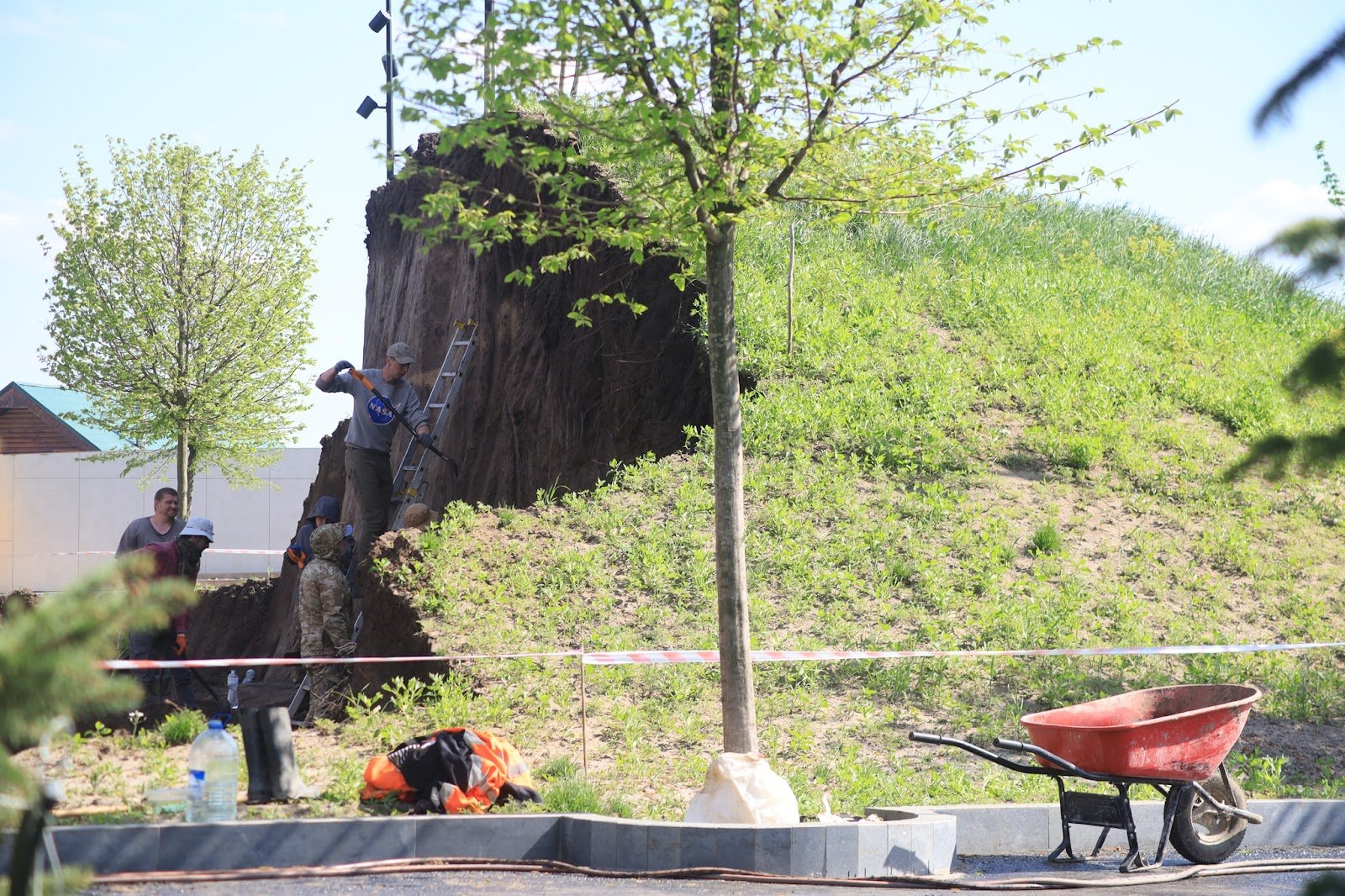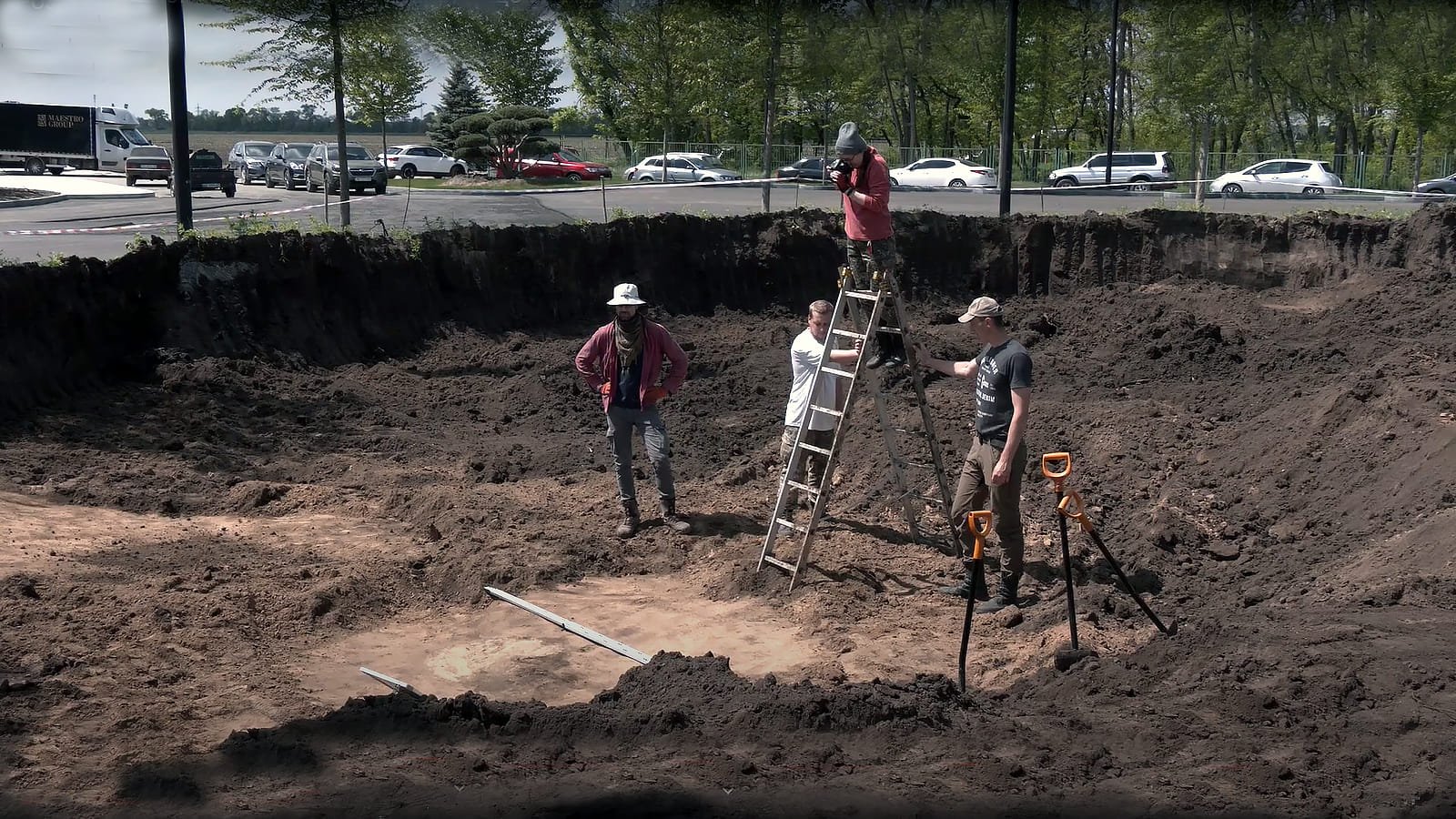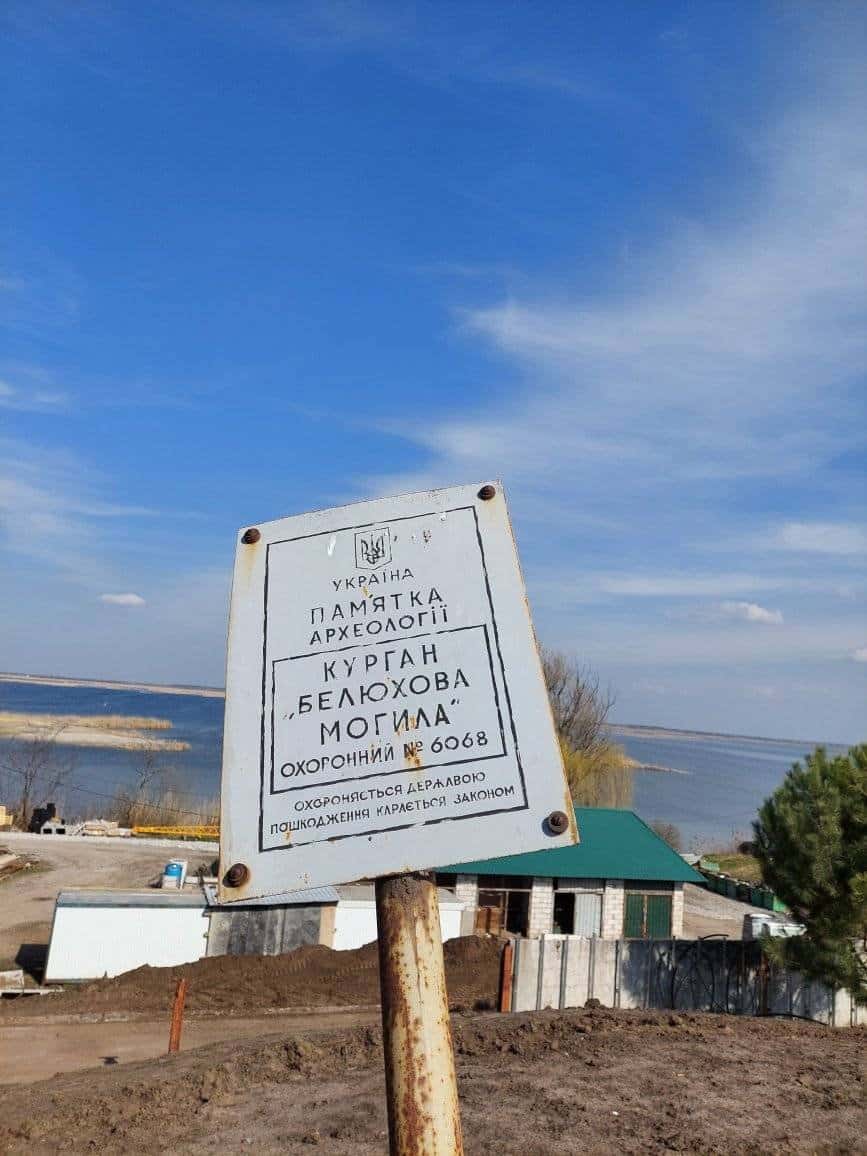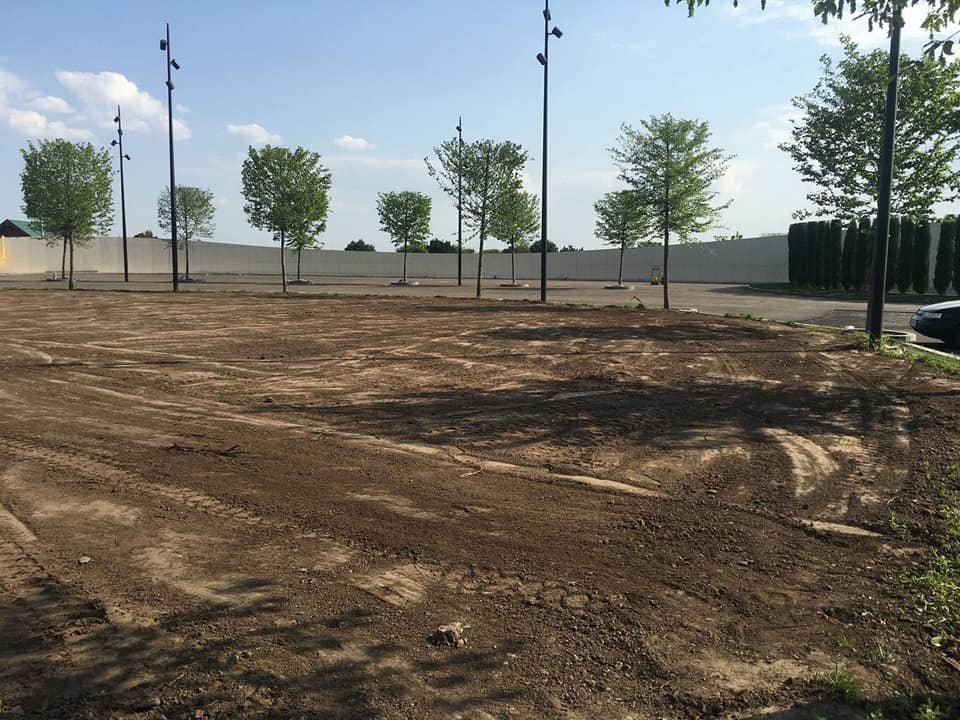Table of Contents
In Ukraine, kurgans are disappearing quietly. In a matter of a few years, under the plow of a modern tractor, such burial mounds are leveled into ridges. Sometimes, social uproar arises around these kurgans. Like, for example, this spring around Kurgan 6068 in Pidhorodne near the Dnipro. Its local name is “Beliukhova Mogyla” (grave). In May, it became known that the kurgan was leveled to the ground, and the monument was removed from the records.
The excavation of the kurgan, which ended up within the territory of an expensive hotel complex, was surrounded by paving stones and curbs. Soon, the kurgan completely disappeared
Source: local activists
The kurgan was unlucky to find itself within the territory of the 5-star hotel complex SunRay. Pidhorodne residents believe that the management of the complex had an interest in demolishing the monument. Allegedly, the complex expanded its territory and encroached upon the kurgan, which ended up in the middle of a parking lot.
In addition to the parking lot, there are also tennis courts, a helipad, and a 50-meter pool there. A stay in a cottage with two bedrooms on the weekend costs 14,200 UAH (379 USD), in a three-bedroom cottage — 20,000 UAH (542 USD). Locals say that Victor Yanukovych used to relax here.
The author called the hotel and talked to the administrator. She asked if it’s true that the location of the kurgan is within the complex’s territory. A female voice replies, ‘I don’t have that information.’ She also requested to submit an information request to the owners of the property, specifically to answer who ordered the excavation of the kurgan and whether the hotel would consider using it as a tourist attraction and advocate for its preservation, as the local residents have done. They promise to respond, but they don’t.
The hotel is registered under the name of Oleksandr Huzenko. He is considered one of the wealthiest residents of Dnipropetrovsk Oblast. In 2019, he ran for the Verkhovna Rada (Ukrainian Parliament) as a candidate of the Party of Shariy.
Activists who stood up in defense of the kurgan state that even in the years 2021-2022, unauthorized activities were carried out within the protective zone of the site. The burial mound was enclosed with curbs, trees were planted near its base, utilities were installed, and lighting was set up.
“Protective zones are established around kurgans because we don’t know what they looked like a thousand years ago. Quite often, there are additional burials and various discoveries in the fields surrounding the kurgan,” historian and former head of the archaeology laboratory at Dnipropetrovsk National University, Viktor Veklenko explains the significance of the area around the kurgan.
In March of this year, equipment and archaeologists arrived at the monument. An excavator began to remove the embankment, while scientists searched for discoveries. During the excavations of the Scythian kurgan, six burials were uncovered. The largest number of them belonged to the Yamnaya culture. This dates back to the 3rd millennium BCE. The findings from the site, mainly pottery, were handed over to the Dmytro Yavornytsky National Historical Museum of Dnipro.
Source: activists of the Guardians of Kurgans movement
No one’s kurgans
Researcher of kurgans and founder of the public movement Guardians of Kurgans Oleksandr Klykavka states that the excavations of Kurgan 6068 also began without permits. The documents only appeared later due to public pressure:
“In March 2023, the Dnipro Archaeological Expedition started the excavations. Local activists came and asked to see the permits. In response, they were told that there was a lot of bureaucracy involved. Activists from Pidhorodne raised an informational wave. After a few days, the necessary documents appeared. They were dated later than when the work began,” explains Oleksandr Klykavka.
All the documentation regarding the excavations is issued under the name of the deputy chief of the Dnipro Archaeological Expedition, Iryna Shabelnykova. When the author asked her about the work without permits, she responded, “I won’t comment on this or engage in debates with opponents, who are hard to call opponents because they lack the appropriate education and knowledge.”
Incidentally, the author asked Ms. Iryna whether the owners of the SunRay complex indeed paved the protective zone of the kurgan with pavement and installed utilities there.
“No. The local authorities were supposed to take the monument and its protective zone under their responsibility, develop documentation for its preservation, ensure that no trash was dumped on the site, and take care of it. None of this was done,” explains the archaeologist.
The author repeated the question: so who interfered with the protective zone of the kurgan?
“That’s not a question for me, but for the Protection Archaeological Service of Ukraine, to which we report,” the author heard in response.
Therefore, according to Iryna Shabelnykova’s words, Kurgan 6068 was supposed to be under the responsibility of the local authorities, but for some reason, it wasn’t.
In the Pidhorodne City Council, documents regarding the transfer of the kurgan to its ownership are absent,” confirms Oksana Kozakova, Acting Chief of the local Department of Culture.
“The Regional Culture Department should have delegated such authority to us, but it didn’t. In that case, we should have conducted monitoring of the kurgans and entered into protective agreements. I personally tried to clarify this matter. However, the Regional Culture Department informed me that they had handed over the kurgans to the district councils. In our case, it was the Dnipro District Council. But this was before the administrative reform, before the reorganization of districts and their reduction in number. Now, the Dnipro District Council says that they also don’t have documents for the kurgans. So, they’re hanging in the air,” said Oksana Kozakova, Acting Chief of the local Department of Culture.
By the way, activists confirm that such a situation with kurgans is widespread across the country — during the administrative reform, they “got lost.”
Ms. Oksana also tried to find out who is listed as the sponsor for the excavations of Kurgan 6068 in the documents.
See also: How Ukrainian museums survive during the great war
“We haven’t been provided with such information. We received private information from archaeologists: there is an investor who financed these excavations. Activists from our community contacted the Ministry of Culture. They replied that they don’t have information about the sponsor. We also approached the Institute of Archaeology, which conducted the excavations. They also didn’t provide the necessary information,” adds Oksana Kozakova.
The protection plate of the destroyed mound. As it turned out, the state does not protect anything, and damage is not punishable by law
Source: Texty media outlet
The “Beliukhova Mogyla” is not the Beliukhova Mogyla
Archaeological work was carried out under the guidance of the head of the Dnipro Expedition of the Protection Archaeological Service of Ukraine at the Institute of Archaeology of the National Academy of Sciences of Ukraine, Dmytro Teslenko. The archaeologist states that the kurgan was in a state of emergency, and information from it needed to be salvaged.
“The emergency condition of the kurgan arises when it is placed in an unnatural environment for it. The protective zone around Kurgan 6068 was not adhered to. According to current legislation, it should be 100 meters. All of it was paved with pavement, which came from an unknown source. Secondly, on the mound itself, since the 18th century, there were trash dumps. The kurgan became overgrown with trees that damage the burial with their roots,” Iryna Shabelnykova recalls.
Historian Viktor Veklenko expresses concern about the way the kurgan was investigated. He states that the soil was exhausted with an excavator. This method could have disturbed not just one burial. The excavation team denies these accusations, claiming that they have modern equipment and qualifications.
After the excavation was completed, the researchers also stated that the Beliukhova Mogyla is not actually the Beliukhova Mogyla.
“The Beliukhova Mogyla is located in a completely different place. Moreover, it’s no longer there. In its place, there are now summer houses. However, people from Pidhorodne have a myth that Kurgan 6068 is the grave of the Cossack Beliukh. So, they concluded that we are destroying their sacred site, which they worship. Archaeological excavations are not about destruction. We have the appropriate qualifications and scientific work. Everything was coordinated with the state. But the public has no understanding of the excavation procedures. Moreover, people are aggressive now. They have directed the anger they accumulated during the war towards us. We just happened to be caught in the crossfire,” explains Iryna Shabelnykova.
Viktor Veklenko agrees that Kurgan 6068 is not the burial site of the Zaporozhian Cossack Matviy Beliukh. However, he believes that this is not a reason to destroy the kurgan.
“The real Beliukhova Mogyla is located a bit further, within the territory of a cottage settlement. However, any kurgan holds value in the information it contains. For example, information about burial rituals. It should be explored calmly, and each stage should be documented. Kurgans should be investigated, but not recklessly. But how is it happening here? They plan some construction and rush to dig,” says the archaeologist.
So, according to archaeologists, Kurgan 6068 should have been urgently preserved. Especially since the Yamnaya culture is currently at the center of archaeological interest all over Europe, according to Dmytro Teslenko. Opponents of the kurgan’s demolition have their own versions of the excavations.
“My version is that the hotel owner needed land for landscaping, perhaps to create lawns. This involves more than 1,000 cubic meters of quality soil, which is currently expensive (a “kamaz” truck with 18 cubic meters of soil costs around 12,000 hryvnias — approximately $450). Another possibility is that the monument protection center or archaeologists pointed out violations that occurred during construction. These could involve breaches of laws regarding the protection of cultural heritage and archaeological heritage. To cover up these violations, they decided to excavate the kurgan under the guise of archaeological work. No kurgan, no problems,” says Oleksandr Klykavka.
Source: Texty media outlet
To take care of a kurgan means simply not to touch it
Oleksandr Klykavka is a public inspector for the preservation of cultural heritage in the Chernihiv Regional State Administration. He responds to violations during archaeological excavations of kurgans. Sometimes he faces resistance from the archaeological service, officials, and the press.
“I’ve traveled around many kurgans in Ukraine, abandoned without any attention! Protective signs and markers are absent. All protective zones have been violated. Agro-holdings, local farmers, do everything they can to plow over them or even drive tractors onto the kurgans, and after a while, just obliterate them completely. And for this, no one will even reprimand them, let alone impose any punishment. Officials are not concerned with this. Therefore, the only response to activists’ letters about violations and calling attention to the issue is: ‘We don’t have the funds.’ To complain about agro-holdings? They have professional lawyers. We even involved members of parliament, and we wrote letters to the prosecutor’s office. No response. Archaeologists are willing to excavate unique heritage sites for a fee, just so that a cottage or a hotel can be built in their place. I understand if a kurgan needs to be removed for an important road or infrastructure, but not to demolish it for a private house or parking lot,” explains Oleksandr Klykavka.
After decentralization, local departments for the preservation of cultural heritage shifted the responsibility for protecting kurgans to local territorial communities. However, at the same time, they did not provide them with the necessary documentation and legal mechanisms to carry out this function. As a result, kurgans ended up in a suspended state, as explained by their defenders.
The kurgans in Bezvodivka, Pryluky district in Chernihiv Oblast, were luckier because they are under the care of Oleksandr Klykavka. The kurgan complex comprises 35 objects. The activist believes that they are up to 4,000 years old and are positioned in a way that they may have served as observatories in the past — used to determine the movement of celestial bodies and other significant astronomical events. However, there are ongoing debates among scientists about the latter claim.
“Taking care of a kurgan is simply not disturbing it. These monuments were created thousands of years ago. In other words, when the first Egyptian pyramids were built, when there was no Greek Parthenon yet. Our kurgans survived world wars, land cultivation, collectivization, but they couldn’t withstand modern construction of cottage towns and land irrigation. I won’t reveal all my secrets about how we manage to protect our kurgans from barbarism. Some tricks helped a little, some blackmail, some persuasion. But the best method of protecting a kurgan is public attention. Under public pressure and exposure, even an agricultural holding can step back” says Oleksandr.
Activists are awaiting a report on the excavations
The kurgans in Bezvodivka have been covered not only by central Ukrainian news agencies and channels but also by international publications, such as The New York Times.
“First and foremost, a kurgan is a grave, an archaeological monument. It is excavated only for scientific research or in cases of extreme necessity, such as due to the construction of an important road,” believes Viktor Veklenko, adding that in such cases, after demolition, a comprehensive scientific publication describing the discovered burials and artifacts should be produced.
“Instead, we have the “Rescue Archaeological Service” at the Institute of Archaeology. They simply destroy the kurgans. At best, every few years, we get a thick volume titled “Archaeological Research in Ukraine,” where a page or two is dedicated to kurgans,” says the historian.
Iryna Shabelnykova, at the same time, promises that there will be a scientific report on Kurgan 6068, and it’s already in progress. However, first, bones and ceramics need to be sent to Kyiv for analysis, and an archival number needs to be obtained.
Such work, she explains, “cannot be done quickly.”
Originally posted by Anna Balakyr on Texty.org.ua. Translated and edited by the UaPosition – Ukrainian news and analytics website
See also: Role of theatrical art during wartime




